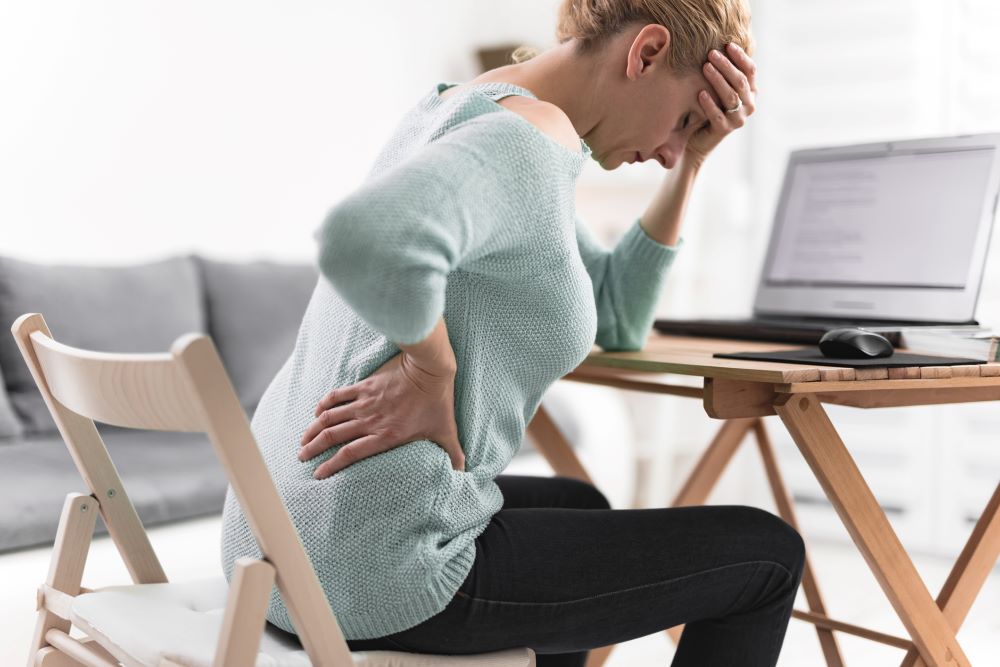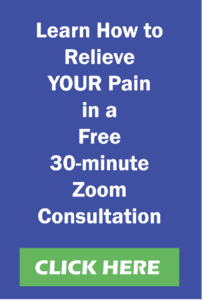Many people who reach out to me for help are doing so because they’ve found their back pain is difficult to treat. Why is it so difficult? I recently read an article in the Sarasota Herald-Tribune and USA Today by Dr. Michael Daignult, entitled “Low Back Pain?” Dr. Daignult reported several statistics from emergency rooms across the country. For instance, 2.6 million people annually visit an emergency room for low back pain and 84% of adults will suffer from some form of low back pain in their lifetime. Dr. Daignult discusses how difficult it is to treat back pain in the ER as most tests like MRI, x-ray, and CT scan are not helpful in stopping the pain. He commonly tells his patients that his goal is to alleviate–not cure–their back pain.
What is important here is that back pain is very difficult to solve for doctors as they do not have the time to figure it out and, frankly, they are not trained to cure it, only stop the pain. It is true that typical scans can show disc issues, pinched nerves, and stenosis, however, the real question we must ask is, what caused that to happen? It is not just bad luck, but a lifetime of poor mechanics.
Typical Treatments for Back Pain
The article, “Low Back Pain?” discusses some of the typical back pain treatments and why some do not work. When these do not work, we could easily assume that back pain is difficult to treat.
Here is the list:
Drugs
Most doctors will prescribe pain killers like acetaminophen or non-steroidal anti-inflammatory drugs (NSAIDS). Acetaminophen can cause liver issues from long-term use and is not very effective. The NSAIDS do work better but may be prohibited for some people as they have other conditions like heart disease or digestive issues. There is a risk of bleeding from NSAIDS if you are over 60. Other drugs like narcotics or steroids have not performed well either.
Alternative Treatments
Alternative treatments like Epsom salt baths or deep tissue massage may help, but more than likely not. The Epsom salt bath doesn’t have enough evidence to support claims made for it. The deep tissue massage usually focuses on the back and anyone who knows me knows that is usually the wrong place to work. He also mentioned handheld devices which in my opinion are worthless. Most back pain is caused by areas other than the back and if you do not release the muscles with the brain, the pain will not stop.
Physical Therapy
PT is a common prescription by most doctors today. This is a hit-or-miss proposition for the patient. There are some good PTs out there that can help you. They must be focused on you and spend the time with you to be sure you are performing the exercises correctly. Unfortunately, too many times a therapist will give you an exercise to perform, then walk away to work with another patient, while not knowing if you are doing the exercise correctly or not. The worst is when they give you multiple exercises and walk away. If you knew how to do the exercises, you would not need a therapist.
It is very rare that back pain, lower or upper, is caused by anything in your back. This is a huge mistake made by professionals and patients alike. We train most health care professionals to treat the site of the pain when the site of pain is almost never the site of the cause. Some doctors may give you an injection for pain. While the injection may stop the pain, the doctor has not changed anything in your body that would eliminate the pain. Any wonder why they think back pain is difficult to treat if they aren’t addressing the real cause of the pain?
Like I said earlier, disc issues, pinched nerves, and stenosis do not just happen if there has been no immediate trauma to the back. These issues come from years of poor mechanics of the pelvis and shoulders. Some will have their bones adjusted when they have back pain, and this works for short periods of time only because the same muscles that pull the bones out of place have not been changed. Therefore, for many people, these tight muscles will just pull the bones back out of place within a few hours or days.
What is Causing the Back Pain
The first step is to identify what is causing your back pain. Once you know why your back hurts, solving it becomes easy. Here is an easy test to better understand the cause of your back pain and realize that it is not really true that back pain is difficult to treat.
It Hurts When You Stand Up…
If your back hurts when you stand up after sitting for a while or getting out of bed in the morning, then the cause may be the front of your thighs, the quads, or it may be the inner thighs. If you place a pillow under your knees when lying on your back for relief, then again, it is probably coming from the front of your thighs or inner thighs. If you feel a need to sit after standing for a while, then it is probably the front of your thighs or inner thighs.
The difference here is where the pain occurs. If the pain is more to the outside of your back above the hips, then it is a good sign it is the front of your thighs. If the pain is more in the middle of your back, then it may be the inner thighs. What happens here is, that when the front of the thighs and inner thighs become tight, or short, both sets of muscles will tilt the pelvis forward which will increase the compression in the low back.
When the pelvis is tilted forward, your upper body may lean forward. You may tighten the muscles in your low back to stand up straight. This adds to the compression which can affect the discs and nerves.
It Hurts When You Sit…
If you feel back pain while sitting, but standing alleviates the pain, then it is a good sign the back of your thighs, or hamstrings, are the cause. The calves will play a role when you stand up. When the hamstrings are tight and you sit down, you are extending the hamstrings which tilt the pelvis backward, increasing the compression in the low back. Once you stand up the compression is removed, and the pain goes away. The calves play a role while standing, though the back pain has stopped. While standing, if the calves, which attach to the hamstrings, are tight, this will cause the hamstrings to tighten. Tight calves cause you to walk with a shorter stride which shortens the hamstrings. The next time you sit down the pain may get worse.
The upper back pain is caused by either tight chest muscles or tight calves. We have two chest muscles that attach at the breastbone and run-up to the outside edge of the shoulder. When the chest is tight, the chest muscles pull on the shoulders causing them to round in. The rounding of the shoulders will lead to a head-forward posture which increases the pressure on the upper back. Surprisingly, when the calves are tight you will have a shorter stride, and this will lead to head-forward posture as well. Most people with a short stride will lead with their noses and not their belly button. forcing their head forward for momentum.
The Relationship Between Front and Back
Once you understand that the front side of your body causes most of the pain on the backside of your body, solving the pain becomes rather easy. Below I have added two videos of common solutions for low back pain and upper back pain. Practice these daily and see if, over a few days, your back pain stops.
In using my technique, you are allowing the brain to release the muscles versus the brute force that you see in many gyms and physical therapy. It takes practice, but once you get it, and you will, your body will feel more energized and vibrant.
Stretching is more about feeling the muscles letting go than forcing them to stretch. If you are forcing the muscle, you could be doing strength training, not stretching. Make sure you are feeling the intended muscle stretching. If not, the form could be wrong. Holding for 5 seconds allows the brain to release the muscle before it senses any danger. Repeating the stretches 10 times allows the brain to learn it is safe for the muscle to move that way.
Don’t forget the Tennis Ball Massage!
Softening your hips and back is easy when you use the tennis ball. Just lean against the wall and apply enough pressure to feel the painful area. The temptation is to press harder but resist it. Instead, breathe out and allow the muscle to soften under the ball. Then move to another spot and repeat. Continue doing this until most of the painful spots are gone. Check out previous newsletters to see the video.
SUBSCRIBE to view all the videos that demonstrate Stretch n’ Release exercises to decrease your back pain dramatically.
Think Back Pain is Difficult to Treat? Start Here
We’re happy to offer you a complimentary 30-min virtual consultation so you can experience this for yourself. Schedule your introduction to Stretch n Release now.
About The Muscle Repair Shop
Drawing upon his personal experience as a former competitive athlete turned wheelchair, obese and chronic pain sufferer, Muscle Repair Shop Founder Butch Phelps decided to take his health into his own hands when at the age of 36 he was told he might not make it to his 40th birthday. Applying balanced nutrition advice from his doctor along with a sound exercise program, he went from 315 lbs. to 180 lbs. Motivated by his experience, he then acquired degrees in advanced therapeutic massage and aging sciences to help people eliminate chronic pain. This included applying his expertise in how people age, including the effects of dementia, anatomy, psychology, and the day-to-day struggles of living as an older person to his practice and development of The Muscle Repair Shop’s one-of-a-kind Stretch n’ Release Technique.
Available through in-office and virtual coaching treatment sessions, this unique combination of stretching and breath work teaches the brain to release the emotional side of muscle tension and pain allowing clients to find lasting relief and healing from stiffness, aches, injuries, and chronic pain. The at-home exercises come with customized instructional videos and virtual or in-office support, allowing clients to enjoy and experience life and sports as they did before limitations slowed or curtailed activities.


